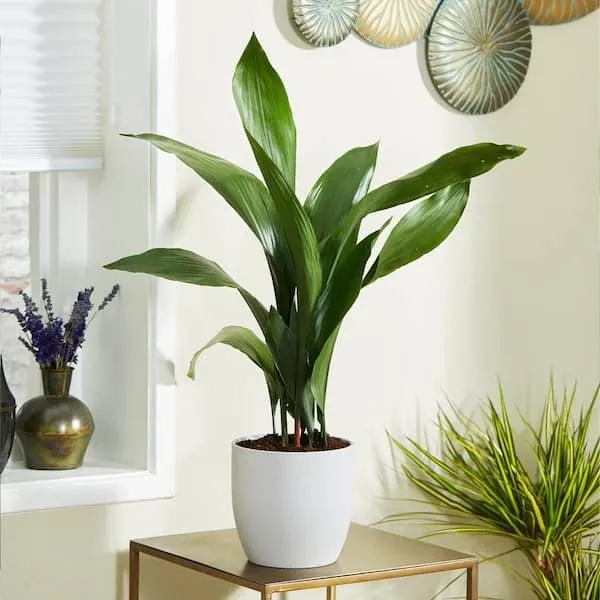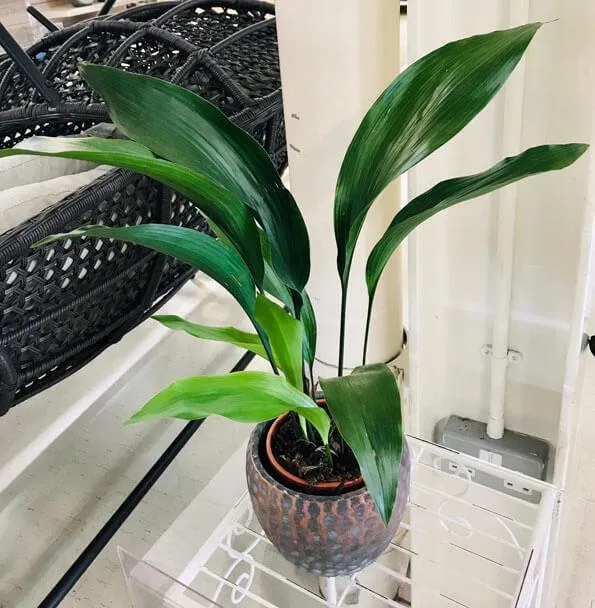Is the Cast Iron Plant Safe for Dogs?
The aspidistra elatior, commonly known as the cast iron plant, is a popular houseplant known for its hardiness and ability to thrive in low-light conditions. But dog owners may wonder – is this plant safe to have around pets? In this article, I’ll explore the cast iron plant’s toxicity risk for dogs and provide answers to common questions regarding its safety.
Toxicity Risk
From my own research and experience as a pet owner, the cast iron plant presents a very low risk of toxicity to dogs. While some plant Databases list it as “possibly toxic,” there are no well-documented cases of dogs becoming ill from ingesting parts of the aspidistra elatior. Its tough, leathery leaves are difficult to digest, so dogs are unlikely to consume large amounts. However, chewing or eating small pieces is still not recommended as a precaution.
The main concern is that like many houseplants, the cast iron plant contains saponins – soap-like compounds that can cause vomiting or diarrhea if enough is ingested. But you’d probably need your dog to eat a whole bunch of leaves for any issue to occur. A nibble or two is unlikely to cause problems for most dogs due to the plant’s low palatability and digestibility.
Symptoms of Toxicity
In the rare event a dog did consume a significant amount of cast iron plant matter and experienced symptoms, signs of toxicity may include:
- Vomiting
- Diarrhea
- Drooling
- Loss of appetite
Symptoms are generally mild and don’t require veterinary treatment in most cases. However, it’s always best to monitor your pet and contact your vet immediately if any issues develop after suspected ingestion of a potentially toxic plant like aspidistra.

Baby and Toy Dogs at Higher Risk?
Some experts suggest smaller dogs may face greater risk than larger breeds, as smaller amounts of plant material could cause tummy troubles for little pups. However, there is no clear evidence the cast iron plant poses any special danger to toy and miniature dog breeds. As with any plant, it’s best to minimize chewing opportunities, especially for curious puppies and toy dogs who may taste test more plant matter than a larger dog would.
Safe Exposure Level?
Basically, there is no definitive “safe” amount of cast iron plant ingestion, since individual dog sensitivity can vary. While small nibbles are unlikely to harm most dogs, it’s kind of impossible to say exactly how much exposure is ok. To stay on the cautious side, it’s best to consider the plant potentially toxic until proven otherwise and simply limit dog access as a precaution.
Dog-Proofing Tips
If you wish to keep a cast iron plant in areas accessible to dogs, here are some tips to help prevent ingestion:
- Move the plant up high, out of a dog’s reach on shelves or tables.
- Use hanging pots or wall-mounts rather than setting plants on the floor.
- Cover soil surfaces with decorative mulch or stones to discourage digging/eating soil where roots are.
- Consider using baby gates, x-pens or closed doors to restrict dog access to rooms with plants.
What to Do if Ingestion Occurs
Despite preventive measures, it’s possible curious dogs may still nibble on cast iron leaves. In case of suspected ingestion, remain calm and monitor your dog for symptoms. Contact your vet right away if any issues develop like vomiting, diarrhea or loss of appetite.
You can also consider inducing vomiting at home using hydrogen peroxide to try and expel any remaining plant material from the stomach (1 tsp per 10 lbs body weight). However, this should only be done for non-toxicTest exposures if symptoms occur within ONE HOUR of ingestion. Otherwise, it’s best to just watch and wait unless advised otherwise by a vet.

Safer Alternative Houseplants?
For pet owners wishing to green up their home with plants but concerned over toxicity, some amazing options that are considered non-toxic include snake plants, pothos, peace lilies, Chinese evergreens and bamboo palm. These can all add lovely foliage with minimal risk to curious dogs.
So in conclusion, while the cast iron plant seems very unlikely to profoundly harm most dogs, it’s still reasonable to consider it potentially toxic and take precautions to limit ingestion opportunities. With a few simple safety measures, you can hopefully enjoy this tough plant’s low-maintenance appeal without worries for pet safety.
Final Thoughts
I hope this detailed overview has helped answer any questions about whether the aspidistra elatior is safe for dogs. From my experience as both a plant parent and pet owner, the risk seems fairly low with this plant. But it’s always better to err on the side of caution with our furry friends. Let me know if you have any other concerns!
Factors to Consider Before Giving Your Dog Aspidistra Elatior
| Factor | Details |
|---|---|
| Toxicity | While aspidistra elatior itself is not toxic to dogs, it is not recommended to give them large quantities as a food source. |
| Allergies | Some dogs may have allergic reactions to aspidistra elatior such as itching or skin inflammation. |
| Preference | Most dogs do not see aspidistra elatior as a desirable food source and it is unlikely they will eat more than a bite or two if given the opportunity. |
| Nutrition | Aspidistra elatior does not provide a balanced source of vitamins and minerals for dogs. It is low in protein and other nutrients dogs need. |
| Risk of gastrointestinal upset | While non-toxic, aspidistra elatior may cause stomach upset in some dogs if eaten in large quantities. |
FAQ
-
Is aspidistra elatior poisonous to dogs?
No, aspidistra elatior is not poisonous to dogs. While some parts like the leaves can cause mild stomach upset if eaten, it’s not considered toxic.
-
Can dogs safely eat aspidistra elatior leaves?
While the leaves aren’t toxic, it’s best if dogs don’t eat them. They can cause indigestion or an upset tummy. However, an occasional nibble probably won’t hurt them too much. It’s best to keep Fido away from eating large amounts.

-
Is it okay for my dog to chew on aspidistra elatior plants?
Generally speaking, it’s fine if a dog gives an aspidistra elatior plant an occasional chewing. The stems and leaves are not terribly tasty to dogs. At the same time, excessive chewing can damage the plant. It’s best to have a plant that’s out of easy chewing reach of puppies and powerful chewers to avoid injury to both dog and plant.
-
Will aspidistra elatior be harmful if my dog eats the dirt it’s planted in?
No, eating small amounts of soil from a potted aspidistra elatior plant is unlikely to cause problems for dogs. Dogs sometimes eat dirt due to nutritional deficiencies or underlying health issues. But most of the time, it’s just them being dogs! The dirt isn’t considered toxic. Nevertheless, it’s best not to let dogs regularly snack on potting soil as it can cause an upset tummy.
-
Can my dog play with an aspidistra elatior plant?
In general, it’s fine for dogs to give an aspidistra elatior plant a sniff or even lay nearby one. These plants are pretty tough and can handle some light pawing or batting around by medium and small dog paws. However, roughhousing right around the plant may knock it over or damage the leaves/stems. It’s best if large and rowdy dogs don’t use aspidistra plants as chew toys to avoid potential injury. Moderation is key when dogs play around plants.
-
Will my dog get sick from the pollen if it brushes up against an aspidistra plant?
Nah, there’s no need to worry about dogs getting ill from aspidistra elatior pollen. These plants produce very little airborne pollen, if any. It would take a dog laying right in the middle of a whole garden of them for hours to potentially cause sneezing or itchy eyes. Even then, it’s unlikely to cause serious issues. So there’s no real harm in letting dogs spend casual time around aspidistra plants.
-
Can I use an aspidistra elatior plant as a dog-friendly houseplant?
Yep, aspidistra elatior plants make good pets for pooches. While dogs shouldn’t be eating large portions, the occasional nibble won’t harm them. They’re also quite durable if dogs brush or lean against them. Plus aspidistra plants produce little pollen so no risk there. Overall, aspidistra elatior qualifies as a remarkably pup-resistant foliage houseplant – amazing for homes with dogs!

